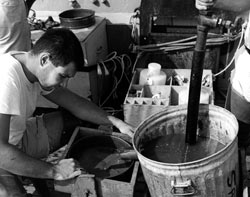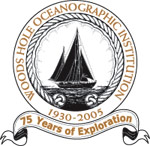This is an archived site. This site is no longer being maintained or reviewed for broken links.
Employee Portrait Gallery—George Hampson
 |
|
|
Just two years into his WHOI career, George Hampson examines seafloor mud samples for benthic animals collected during a cruise of the original Atlantis in 1963. Analysis of deep-sea samples, photography of invertebrates, and the design of benthic dredging equipment became some of his specialties. (WHOI Archives Photo) |
“Woods Hole was a sacred place for us—a mysterious place,” said George Hampson, recalling his family’s visits to the village in the 1930s and 40s. “The lights in the science buildings were always on at night, and it seemed to me as a kid that those people must never sleep. We would drive down to see what was going on and to inspect the ships. I would think: ‘I’m going to work there someday.’”
George was born in Holyoke, MA, but if you ask him, he will say with a smile that he is a Cape Codder. His family summered in Pocasset, near a small, marshy creek that provided an “open school” to learn about the water and the critters living in it. When he was a teen, his family moved permanently to Nye’s Neck in North Falmouth.
After schooling at Tabor Academy and an undergraduate degree from Northeastern University, he found work in 1958 assisting WHOI biologist Howard Sanders with an ecology course at the Marine Biological Laboratory. He joined the U.S. Army in 1960, but was back on the streets of Woods Hole within a year, serving as an Army reservist and looking for work. Sanders soon hired him as a research assistant for WHOI.
For 37 years, he worked alongside Sanders and colleagues that included Hovey Clifford, Bruce Tripp, Bob Hessler, Fred Grassle, Rose Petrecca , and John Farrington. He was a jack-of-all-trades—field sampler, lab analyst, diver, naturalist, and biochemist—who contributed to studies of marine invertebrates from the intertidal zone to deep water. He worked extensively with Sanders, Max Blumer, and two generations of scientists exploring the effects of oil spills on the marshes and coastlines of Buzzards Bay. He also worked to find and classify many species of benthic animals, particularly the primitive, throwback crustacean known as the cephalocarid, which was discovered by Sanders. Among many visitors to the Sanders lab, the most famous was probably the emperor of Japan.
George’s interest in the ocean and coast carried over into his home and civic life. He went to his first public hearing in the early 1960s, and he has been actively involved in local government and resource management ever since. He served on the planning board for the Town of Falmouth, as a founding board member for the Coalition for Buzzards Bay, and he now chairs the Falmouth Coastal Pond Management Committee. He was a founding member of the 300 Committee, a non-profit land trust organized in 1985 to preserve Falmouth’s open spaces.
Though he officially “retired” from WHOI eight years ago, George is still hard at work on several coastal programs, including the Massachusetts Estuaries Project, a group that studies water quality in 89 embayments around the state. One of his favorite activities is teaching people of all ages about the coast and coastal waters. “I am just giving something back for all that I have gotten from this community,” he says.
[back]

